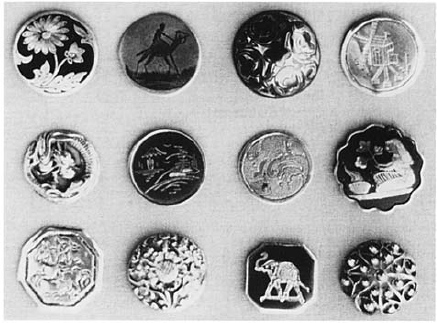Buttons (10 page)
A selection of Brooks buttons, individually hand-painted on plastic by the late Edith and Alan Brooks of Haxby, North Yorkshire. These buttons were part of their range of usable artistic items. They came to the notice of American button collectors, who provided a regular market until the retirement of the Brookses in 1986.

Nineteenth-century tortoiseshell buttons. The three large ones are inlaid with silver, brass and pearl, on a horn base with metal shank. The four small buttons are inlaid with ivory and silver on a horn base with metal shank.

A selection of late-nineteenth- and early-twentieth-century vegetable ivory buttons. The centre button on the bottom row shows the brown blemishes regularly seen on vegetable ivory buttons.

A selection of twentieth-century vegetable ivory buttons designed to incorporate the skin of the nut.
Wood
was used to make buttons in the twentieth century, particularly during and after the two world wars when other raw materials were scarce. Many buttons were made simply of turned and varnished wood, bringing out the natural beauty of the grain. Wood made a good base for inlays and could also be stamped with a design and painted.

Mid-nineteenth-century papier mâché buttons with pearl inlay.

A selection of twentieth-century wooden buttons, carved, stamped, painted and inlaid.
There is a bewildering variety of buttons to tempt the collector. To collect on a theme narrows down the choice considerably and can enhance an existing passion by adding a further dimension – a collection of silverware, enamelware, Satsuma porcelain or Ruskin vases, for example, can be enlivened by a display of appropriate buttons. If the interest is in a particular period in history, or a particular style, buttons offer an additional medium to demonstrate the tastes of that time. For people who cannot resist anything in the image of perhaps a dog, horse or elephant, buttons make an interesting alternative to a china ornament or a cuddly toy. It can be a highly selective and consequently slow task to collect buttons thematically, but the results are well worth the effort.
Mounting a collection of buttons must suit individual taste, but it is as well to bear in mind that excess sunlight, heat or damp will cause damage. There may be personal associations reflected in the collection, and memories of some of the original owners or special outfits long gone. Incorporating appropriate photographs in the button arrangement can be effective. If the interest in buttons springs from an interest in needlework, buttons can be included in embroidery, decoupage or quilt work. Home furnishings can be greatly enhanced by button decoration.

A selection of metal glove buttons. This type was attached to the glove by means of a thong or tape as shown. This method saved wear on the material but gave a firm fixing allowing flexible movement of the wrist. Some gentlemen’s buttons were also attached to their jackets by this method.

Metal buttons from around the world, all twentieth-century unless detailed. (Top row, left to right) Deccan button from India, stamped metal with black paint and a back mark of a factory name and place in the Deccan province; Middle Eastern, etched and blackened silver, known as niello work; Russian silver with blackened pattern; Dutch, nineteenth-century, with a windmill design on silver. (Middle row, left to right) Chinese silver button, dragon with enamelling; Japanese damascene; Middle Eastern, hand-engraved on silver; Japanese imitation damascene. (Bottom row, left to right) Dutch, nineteenth-century silver in a traditional pattern; continental, nineteenth-century, hand-engraved silver domed two-piece; Siamese silver; continental filigree silver.
It is more than likely that, if you do own a button box, tucked away in a corner are treasures with too many sentimental associations ever to risk using and losing them. Many people do not consider themselves button collectors, perhaps just button keepers; but once you start adding to that store, you become part of the fascinating world of the button collector.
Books about buttons
Epstein, Diana, and Safro, Millicent.
Buttons.
Thames & Hudson, 1991.
Hughes, Elizabeth, and Lester, Marion.
The Big Book of Buttons.
New Leaf Publishing, USA, 1991.
Luscomb, Sally C.
The Collector’s Encyclopedia of Buttons.
Originally published by Bonanza Books, USA, 1967. Reprinted by Schiffer Publishing, USA, 1999.
Meredith, Alan and Gillian, and Cuddeford, Michael J.
Identifying Buttons.
Mount Publications, 1997.
Peacock, Primrose.
Discovering Old Buttons
. Shire Publications, 1978.
Perry, Jane.
A Collector’s Guide to Peasant Silver Buttons.
Lulu.com
.
Additional information on buttons can be found in books on a variety of topics such as fashion, manufacturing materials and techniques, and biography. Such reading adds to one’s knowledge of this diverse subject.
Eckstein, E., and Firkins, J. and G.
Gentlemen’s Dress Accessories.
Shire, 1987; reprinted 2000.
Katz, Sylvia.
Early Plastics.
Shire, second edition 1994.
Lansdell, Avril.
Everyday Fashions of the Twentieth Century.
Shire, 1999.
Morgan, John.
Conservation of Plastics.
The Plastics Historical Society, 1991.
Richards, Alan.
The Extraordinary Adventures of Benjamin Sanders, Buttonmaker of Bromsgrove.
The Bromsgrove Society, 1984.
The British Button Society produces a quarterly magazine,
Button Lines.
The Membership Secretary is Mrs Angela Clark, 32 Chichester Road, Tonbridge, Kent TN9 2TL. Telephone: 01732 364309. Email:
[email protected]
.
Website:
www.britishbuttonsociety.org
The National Button Society of the USA publishes
The National Button Bulletin.
Secretary: Susan Porter, 1564 Wilson Road,
Ramona, CA 92065-3539, USA.
Website:
www.nationalbuttonsociety.org
.
